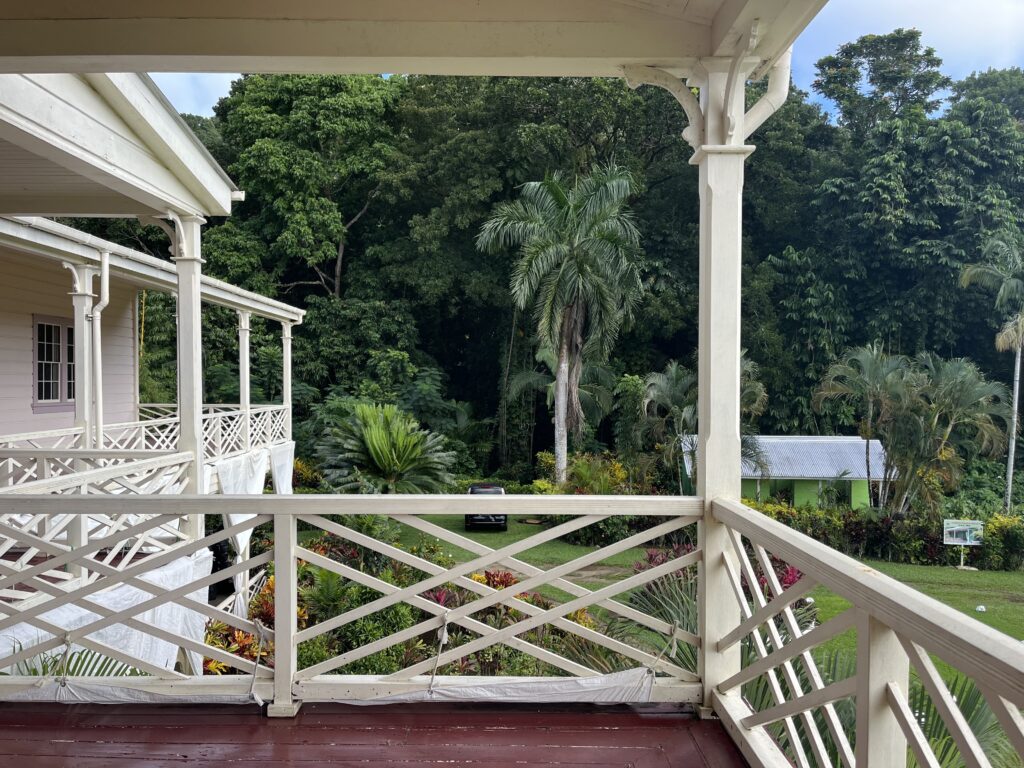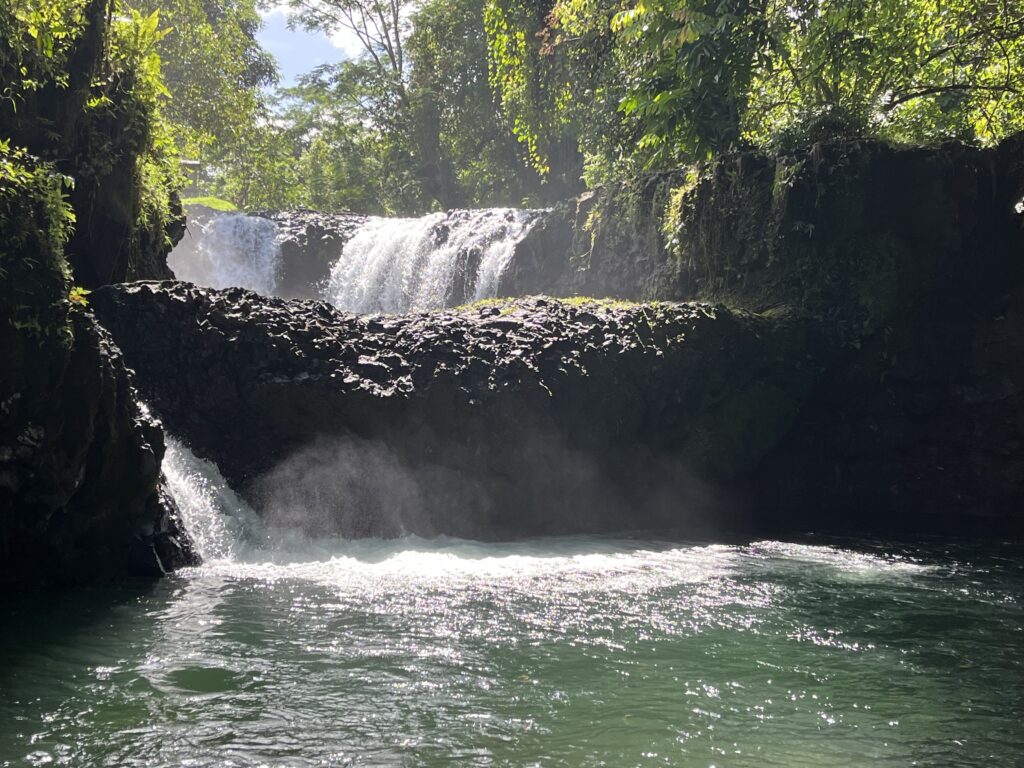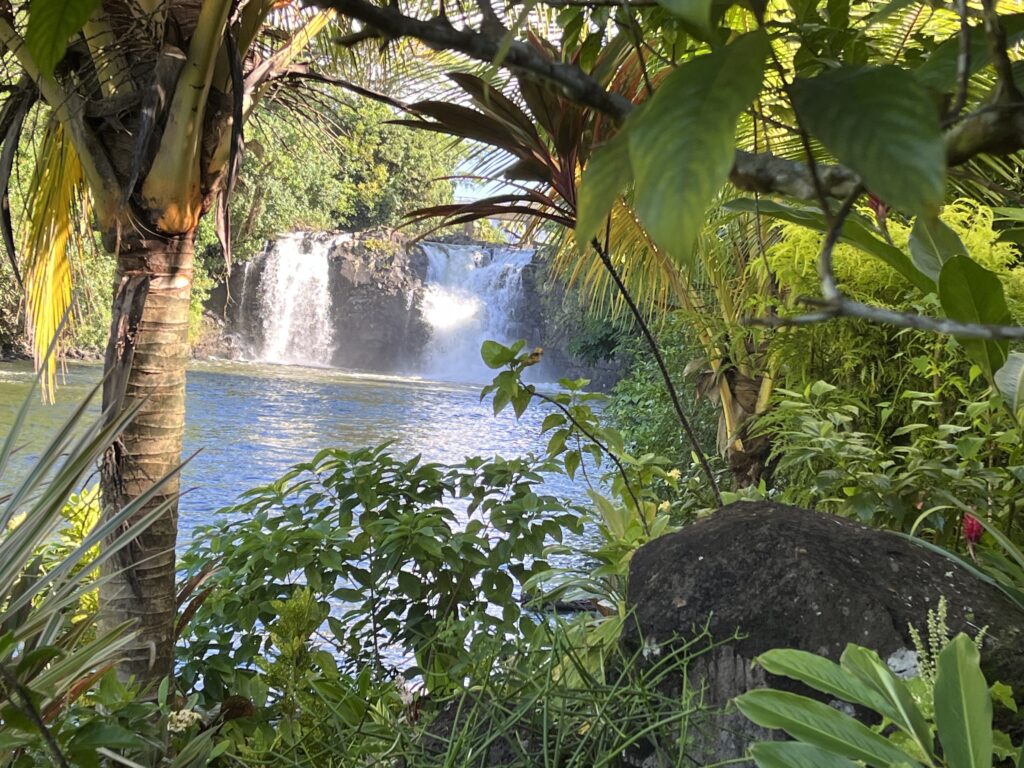Our plan had been to go from Palmerston to Niue and then to Vava’u, a group of islands in northern Tonga. While we were preparing for the trip, we were also watching the weather. It was clear that some heavy winds and waves were coming up from the south and would soon arrive in Palmerston so we needed to move. The problem was that the same weather that would make Palmerston unsafe, would be just as bad in Niue and on the route in between (red line in map). It looked like the only good option was to head north to American Samoa or Samoa, formerly called Western Samoa.
That added quite a bit to the length of the trip, turning a 3 day, 400 nm trip into a 5 day, 685 nm trip. We left Palmerston May 24 and sailed toward the Samoas (the yellow line). Even though we headed north to avoid the worst of the weather, it was still a rough trip. Winds were generally 18 to 28 knots with seas 2.5 to 3 meters. But every few minutes, a 3.5 meter set would hit us. The seas were supposed to be mostly from behind, which makes a comfortable ride, but the reality was two different sets, one on beam and the other coming in at 45 degrees off the port bow. The two would combine in ways that made a very uncomfortable passage and it was often quite difficult to move around on the boat. And we were both feeling a bit of motion sickness. Not a fun passage.
Initially we were thinking of going to American Samoa because they are a US territory, which means US Postal Service. We hoped to be able to get things delivered from Amazon and other US-based ecommerce sites. American Samoa also has a military base and we could shop at the stores on base. But the harbor at Pago Pago has a reputation for being smelly (the tuna canning factory) and not a very safe anchorage. Then we looked at how long it would take for things to arrive via US mail and decided we did not want to be in Pago Pago for 3 to 4 weeks. So we went right by American Samoa and into the harbor at Apia in Samoa.

As it turns out, there is a marina in Apia and we were able to get a slip. The route in was very tight, but Peggy did a great job of threading the needle while dealing with significant cross winds.
The marina is not in very good shape. They had put a lot of money into upgrades several years ago and a cyclone promptly wiped out most of the marina. They salvaged what they could and are just getting by, expecting the next cyclone to kill the marina for good. That’s too bad because it is in a good location and the woman who runs it is terrific. Very helpful with checking in and out, a wealth of knowledge for local resources and just a nice person.

There is a restaurant / bar right next to the marina. Very convenient if you don’t care what time you get to sleep on Friday or Saturday night.

We spent some time walking around town. We went into the Church of the Immaculate Conception and then had a cappuccino at the Immaculate Cafe that also sells all sorts of religious things. The coffee was not bad and the people were very nice. We also visited every hardware store we could find. I was looking for a number of things like water filters, fuel filters and a 12v water pump. I did not find any of these, but I did buy a number of other ‘just in case’ items. We also did quite a bit of provisioning.
Our outboard motor (a 2 stroke, 15 hp Evinrude) was ancient when we bought Calista. I had it serviced, but it had been getting more and more finicky. It finally ended up with the coolant system not working and the bolts covering the cooling pump impeller were hopelessly corroded. So it was time to buy a new outboard. Luckily, we found a place that sold 2-stroke 15 hp Yamaha outboards for a reasonable price. So we are now the proud owners of this beauty:

On our trip from Palmerston, the main halyard had frayed through its cover. The pic below was taken while sitting in a bosun’s chair just below the top of the mast. You can see the frayed main halyard where it comes off the pulley. I am not absolutely sure how it happened, but I think that with the seas so big and confused, the top of our main sail flopped back and forth constantly for days, and I think this rubbed the halyard against the edges of the metal slot. I am still trying to work out how to prevent this. It has never happened before. I think I need to make sure I don’t have the mainsail all the way up in really sloppy seas. Luckily, fixing is not too hard. I will end up with a halyard that is about 2 ft shorter, but I had at least 10 ft extra so that should be fine. As long as it does not happen again…

We did find time to play tourist as well. We hired Henry, a taxi driver and tour guide, to give us the island tour. It was an all-day, 9 to 5 tour that included waterfalls, a huge sink hole, a nice lunch and great views. It starts with a tour of the home Robert Louis Stevenson, built in Samoa in 1890. He lived there until his death, at the age of 44, in 1894, and is buried on a hilltop overlooking the estate. RLS had become very involved in Samoan politics and is remembered warmly for all he did for the people of Samoa.

Samoa is a mountainous, volcanic island with lots of rain. This means waterfalls!


We had a nice swim in the pool below the waterfall above. Refreshing, not too cold! 🙂

The south coast is much less developed and has many beautiful views.

This sink hole gets fresh water from a spring but also has an underwater cave that joins with the sea. The water is 3 to 10 ft deep and there is quite a strong current flowing in and then out with each swell from the ocean.

Henry, our tour guide, went fishing while we ordered lunch.

While we were there, Samoa celebrated their Independence Day (from New Zealand). It’s a little odd, because they became officially independent on January 1, 1962, but they celebrate on June 1. There were marching bands (in the rain!) and numerous cultural events all week. We went to one (clearly aimed at tourists) that showed how to weave trays and baskets out of palm fronds, how they do traditional cooking, and a demonstration of wood carving using the old tools and methods.



It was REALLY hot and humid in Apia. We ran the aircon for a bit the first night, but that requires a lot of power, so we ran the generator. The marina does have power at each slip, but it is 240v, 50 Hz, and uses a plug only found in New Zealand. Because I anticipated being in marinas with 240v and 50Hz, I had installed one ‘shore power’ plug feeding into a system that can handle any voltage from 90 to 270 and any frequency from 40Hz to 80Hz. But I did not have the right plug. I went to every hardware store I could find, and could not get the right plug. So I “hot-wired” directly into the power pedastal. It had a circuit breaker so I could turn off the power and do it safely. I also cleared it with the lady who runs the marina. She said “Others have done this, and if you can do so safely, I will look the other way.” It worked out well, and we could run the AC without running the generator. Of course, I put things right before leaving.
Our next goal was Tonga. When I crossed the Pacific in 2016, Tonga, the Vava’u group in particular, was my favorite place. So this was our next goal. However, we saw that we could break up the two day trip into two one-day trips by first going to Niuatoputapu, a small Tongan island that had a well protected harbor and could do international check-ins. So on June 9 we left our slip in Apia bay and headed for Tonga!

Glad to hear you really pay attention to the weather. Wishing you safe smooth sailing ahead…